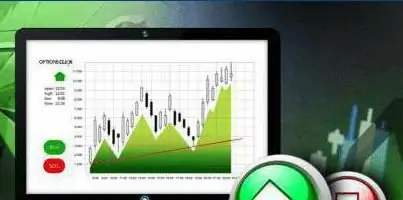2025 Author: Howard Calhoun | [email protected]. Last modified: 2025-01-24 13:10:26
An exchange option is a contract that gives the right to buy or sell a certain asset. Options can be bought or sold on the futures financial markets. Its main difference from this kind of securities is the absence of an obligation to buy or sell an asset after the expiration of the contract. Do not confuse a stock option with a binary one. A binary option has the character of a bet, where the main task for a trader is to guess the direction of the market in a certain period of time.
What is an option in simple terms, what can it be compared to
The easiest way to explain what stock options are, what they are and how to make money on them is with a concrete example taken from real life. For example, someone, say Yura, is selling a house (asset) for 1 million rubles, and Vasya wants to buy this house from him, but Vasya will have the required amount only in six months. Vasya agrees with Yura that he will wait and hold the house, and leave 100 thousand rubles as a deposit.
But after 4 months it turns out that Vasya cannot pay 1 million rubles for the house or changed his mind about buying it. At the same time, in six months the market price of the house rose to 1.1 million rubles. And Vasya, in order not to lose the deposit, decidescede your right to buy a house for 1 million rubles to Petya, who has the required amount or will have it by the required date. Vasya takes 50 thousand rubles for the assignment of the house (asset) at a price below the market price from Petya.
As a result: Petya will buy a house at a price below the market price, Yura will quickly sell the house and receive 1 million rubles, and Vasya will return the deposit and, on top of that, another 50 thousand rubles of income from the transaction. If Vasya had not resold the right to buy a house (asset) at a fixed price, he would have lost his deposit, but he made good money anyway. If Vasya had not agreed with Yura, then Petya would not have been able to purchase a house for 1 million rubles at the time of purchase, since its market price was 1.1 million rubles. At the same time, Yura risked no less. If the price of the house fell to 900 thousand rubles, he would not be able to get the desired amount or could not sell it at all. At the same time, Vasya did not sell the house to Petya, but the right (option) to purchase it at a bargain price.
Although this example has nothing to do with the exchange and trading on the exchange, it shows how the buyer of the option and due to which he receives income. Buying or selling an asset at a predetermined price makes it possible to reduce the risk of loss from random market price fluctuations. Real estate prices, especially in Russia, do not change as quickly (moreover, in two directions) as in the above example. However, in financial markets, sharp swings, ups and downs are a common occurrence. Participants in the stock or currency market never know exactly what the price will be for a particular asset in a week or a month.

Types of stock options
Usually they are divided into two types: a contract for the purchase of an asset (call) and a contract for the sale of an asset (put). The choice of buying one or another option depends on the situation on the market and the possible reward (loss) for the risk taken.
Call Options
They are used when an investor, while trading on the stock exchange, is afraid of a sharp rise in prices and wants to take profits at a certain level for a certain period of time (day, month, year). To do this, he acquires a contract that the asset will be purchased at a fixed price, and pays a deposit (premium). Even if the price jumps, the investor has nothing to lose, as he will be able to buy the asset at the contract price, and not at the market price. If the price falls, then he may simply not implement the contract, but buy assets that have fallen in price, while losing only the collateral or not buying them at all.
Put options
These options are used when the investor wants to hedge against a fall in prices. The principle of risk insurance is the same as for call options, the only difference is that a put option is purchased to reduce losses in the event of a price drop.

There are also several different derivatives, which are called options: binary, Asian, barrier, etc. They essentially represent a completely different type of financial instruments, therefore, this article is not considered, since operations with them are of a gaming nature. Such options do not perform the main function, forwhich stock options were created - insurance.
Where they sell
Options trading is buying objects with a limited life and selling them for a limited period of time. Therefore, they are sold and bought in futures markets. That is, they are traded on separate sites using software specially designed for such financial transactions.
According to the place of sale, contracts are divided into exchange and over-the-counter options, the latter can be purchased or sold on the Internet or in person. For example, when transferring an asset to trust management with subsequent sale or exchange for another asset. Modern means of communication allow trading on independent sites on the Internet. The over-the-counter options market is highly developed in the US. According to some reports, the volume of over-the-counter trading there reaches 60% of the total volume. The popularity of this method of trading is due to the fact that there are no or very low commissions on transactions on OTC sites. In Russia, options can be traded on the Moscow Exchange. Exchange options on the Russian stock exchange are sold and bought using the FORT system specially designed for this.

How you can benefit
You can benefit from financial transactions with stock options by selling them at favorable prices on the derivatives market. The speculator should take into account that the option is a perishable product, if he does not sell it on time, he will lose all invested funds, and if the situation isthe market will turn unfavorably and the price will start to fall, but if the trader manages to sell the contract, he will be able to return only part of the funds.
Investors use options as insurance, and speculators use them as an object for subsequent resale. An option is also listed on the stock exchange and has its own price, which changes under the influence of supply and demand. Due to these market fluctuations, the speculator can profit.

Who is the main buyer of options
Options are used by investors, companies engaged in international trade (when buying/selling foreign currency), speculators. Investors and companies are the main buyers of options. They buy them to minimize losses from random fluctuations in the assets they buy or sell. For example, an Italian company supplies furniture to the United States. To protect herself from random currency fluctuations, she buys a contract to sell $1 million per euro in four months at a certain rate, for example, on the date of the contract. If it fails to do so, it risks losing some of its cash earnings in euros if the price of the euro rises during this time.

Basic options trading strategies
Different strategies are used for options trading. Usually, they take a ready-made one developed by other people as a basis and, after some changes, use it. Below are several strategies for trading stock options.
Strategies are taken from the textbook "Options Trading" by M. Tommerset. Novice investors and traders can use them, but they should remember that the examples given may not suit them due to individual characteristics, such as risk appetite, temperament, intelligence level, etc.
- Vertical spread. The bottom line is to use the harmonic fluctuations in the price changes of the underlying asset. The price, one way or another, all the time moves around a certain value and periodically returns to the previous level. The main thing when applying such a strategy is to correctly calculate the time range.
- Bull spread. This is a pretty simple strategy. An investor buys a call option on a growing asset and sells it after a certain period. Profit is generated by the difference between the price of buying an asset and selling it.
- Bearish spread. An investor buys a put option in a falling market. The lower the share price falls, the higher the price of the exchange option.
- Box spread. The bottom line is to buy call and put options on the same asset. Such a strategy is considered a win-win, because no matter which direction the price of the underlying asset goes, the profit from the sale of a winning option will more than cover the loss from a no-win one.
- Calendar (time) spread. An investor buys options with different expiration dates on the same asset. If the first contract by the current moment turns out to be unwinnable, then maybe the next one will turn out to be winning, as sooner or later the price will turn in the other direction.
As seen fromof these strategies, in their work, traders take into account such factors as time (period), the price of the underlying asset, the purchase price of the option and their changes.

How to determine benefit
The benefit from the exercise of exchange options is determined by two parameters - the ratio of the purchase price and the sale price, or by what benefit (savings) the purchase or sale of an asset under the contract brings, and not at the market price. In the first case, the trader benefits from selling the option at a price higher than the purchase price, while in the second case, the benefit can be obtained by fixing profit (loss) at a certain level or buying an asset at a price below the market price or selling it at a price above the market one.
Example
The investor purchased 1,000 shares of PJSC “…” at a price of 120 rubles per share, and a month later the shares were already quoted at 140 rubles per share. He wanted to insure himself and take profit just in case. To do this, he acquired a contract for 12 thousand rubles, according to which he will be able to sell shares at this price in 2 years. If the price falls, he will not lose his 20 rubles of profit, since he has a contract. If the price rises, he will be able to sell the shares at a better price, since he is not obliged to fulfill the terms of the contract. In this case, he will lose only the fee for the contract - 12 thousand rubles.
Consequences of non-implementation of the contract
Exchange options are an effective financial instrument that helps protect profits from sharp market fluctuations. If the investor does not use this tool, then he risksbe left without pants if the market changes direction. At the same time, if he, using a stock option, does not apply it, that is, does not acquire the underlying asset in accordance with the contract, he risks losing only the deposit left and no more.

Advantages of an option as a financial instrument
The main advantage of using stock options is the risk minimization. In fact, trading with an option creates a condition for almost risk-free exchange trading, since losses are strictly fixed. However, traders who do not know how to make money on exchange options by making speculative transactions can lose money on them. Misjudgment of market direction and frequent loss of collateral (premium) can ultimately ruin an investor. This means that he should not rely on the option to replace market analysis.
In order to trade options successfully and profit from such trading, a trader will have to monitor two markets at once: the change in the price of the underlying asset and the change in the price of the option in order to sell it in time, thereby minimizing the possible loss on the transaction. And if for an investor an option is an effective way to reduce risk, then for a stock speculator it is a very complex financial instrument with a high percentage of profitability.
Recommended:
Make money on the Internet on assignments: ideas and options for earning money, tips and tricks, reviews

There are a lot of ways to make money on the Internet without investments and deception. But where and how much can you earn online? Is it necessary to create your own website? How to get the first profit? What tasks need to be completed in order to receive income, and how to withdraw money?
How to make money without money? Ways to make money. How to earn real money in the game

Today everyone can make good money. To do this, you need to have free time, desire, and also a little patience, because not everything will work out the first time. Many are interested in the question: "How to make money without money?" It's a perfectly natural desire. After all, not everyone wants to invest their money, if any, in, say, the Internet. This is a risk, and quite a big one. Let's deal with this issue and consider the main ways to make money online without vlo
How to make money on binary options. Find out if you can make money on binary options

Earnings on the Internet are of interest to many today, so we will touch on the topic of how to make money on binary options. Let's take a closer look at the main strategies that are suitable for those who want to try themselves as a trader
Binary options: reviews. Verum Option: how to make money trading binary options

Verum Option binary broker review: trading strategies, minimum deposit and rates, demo account, trading platform, assets, training, expert opinion and reviews
Who is a blogger and how do they make money. The most famous bloggers - achievements and interesting facts

Many people are interested in how bloggers earn and where they get such fees from. Despite the fact that the Internet has been developing for a long time, many do not understand how you can get money just sitting at a computer. In fact, there are already a lot of professions and methods of earning money connected with the Internet. Writing unique content and constantly updating the blog gives them the opportunity to earn money and sometimes very good ones

